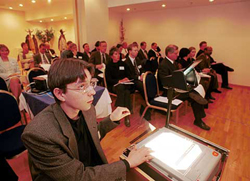07.07.2006 13:08
 By Yelena Andreyeva
By Yelena Andreyeva
Special to St. Petersburg Times
The state of the city’s transport infrastructure came under the spotlight at SPIBA’s (St. Petersburg International Business Association for Northwestern Russia) general meeting, June 20.
At the St. Petersburg Economic forum in June, two city construction projects were named along with four other national projects as recipients of Russia’s investment fund. The building of the Western Speed Diameter road will receive 28 billion rubles ($1 billion) and a section of the high-speed highway between Moscow and St. Petersburg — 25.8 billion rubles. The forum also staged a presentation of St. Petersburg’s Orlovsky road tunnel, that is planned to run under the Neva River between the Piskarevsky and Bolsheokhtinsky bridges.
The Western Speed Diameter is a 46.4 km long highway that will connect the southern part of the city ring road with the Big Port, run across the western part of Vasilievsky Island and north to the “Skandinaviya” highway (E-18.). The construction of the southern part of the Western Speed Diameter started in September 2005 and opens in 2008. According to the plan, therefore, the new highway will connect the north-western, central and southern parts of the city, circumventing the historical center and strengthening links along the federal highways to the Baltic and Skandinavia. In this way it will play a vital part in boosting the competitiveness of Russia’s transport system.
The Orlovsky Tunnel is also aimed at connecting the left and right hand banks of the Neva in order to divert traffic from central bridges. It will provide a twenty-four hour link between the historic center and the ring road and federal highways “Skandinaviya” and “Kola.” Private investors will be sought to run the toll tunnel.
Among the other projects discussed at the meeting was the reconstruction of the Moskovskatya Tovarnaya station (near Moskovsky Railway station) where the Gazprom City office block is planned.
“As for transport communication between St. Petersburg and Moscow, we predict that the business passenger will soon prefer high-speed trains to planes,” said Nikolay Asaul, deputy chairman of the committee for investments and strategic projects of St. Petersburg.
“The city’s airports are located in the outskirts, and even now it takes almost the same time (4.5 hours) to get from Moscow to St. Petersburg either by plane or by a high speed train.”
It is thus hoped that the construction of skyscrapers, such as Gazprom’s, will maximize use on what is expensive land while conveniently locating the corporation’s office all in one building, in the center, close to the railway station.” According to Asaul, a whole host of surveys were carried out to make sure the new skyscrapers do not affect the city’s historical architectural ensembles.
“It was SPIBA’s members who initiated discussion on the development of city transport infrastructure,” said Natalia Kudryavtseva, executive director at SPIBA. “It influences all aspects of the city economy and business, industrial and commercial buildings, transport services, tourism, and is crucial for the development of St. Petersburg as a business center, something very close to the hearts of our members.”
News source: times.spb.ru
 Print this news Print this news
Business news archive for 07 July' 2006.
Business news archive for July' 2006.
Business news archive for 2006 year.
|